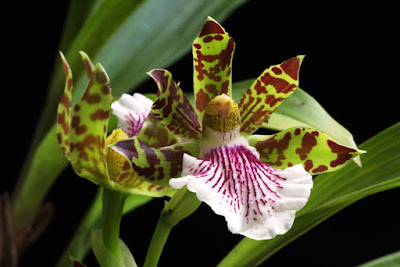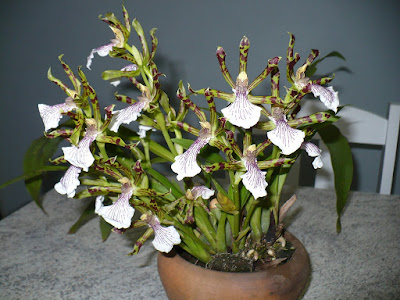Zygopetalum crinitum is endemic to the Serro do Mar and Serra de Mantiquiera, in Brazil. It is found in dense ombrophilous forest in the lowlands but mostly in the cooler moist mountain forests of southeastern Brazil, in the Araucaria moist forest and the Serro do Mar coastal forests ecoregions, from 50 to 1600 m above sea level.
Zygopetalum crinitum also called as The Hairy Zygopetalum, Zygopetalum claesianum, Zygopetalum crinitum var coeruleum, Zygopetalum crinitum var roseum, Zygopetalum crinitum var rubellum, Zygopetalum crepeauxii, Zygopetalum intermedium, Zygopetalum mackaii, Zygopetalum mackaii var. convexum, Zygopetalum mackaii var. crinitum, Zygopetalum microtis, Zygopetalum pubescens, Zygopetalum stenochilum, is a species of the genus Zygopetalum. This species was described by Conrad Loddiges in 1831.
IDENTIFY ZYGOPETALUM CRINITUM PLANT
Zygopetalum crinitum is endemic to the Serro do Mar and Serra de Mantiquiera, in Brazil. It is found in dense ombrophilous forest in the lowlands but mostly in the cooler moist mountain forests of southeastern Brazil, in the Araucaria moist forest and the Serro do Mar coastal forests ecoregions, from 50 to 1600 m above sea level.
It is a medium sized, cool to warm growing terrestrial or epiphyte, that has clustered, often buried in leaf litter, ovoid or ovoid-oblong, compressed, lightly sulcate, shiny dark green pseudobulbs carrying 3 to 5 apical, coriaceous, narrowly lanceolate or linear-lanceolate, acute or shortly acuminate, plicate, long-attenuate below leaves.
The Hairy Zygopetalum blooms on an erect, to 45 cm long, 3 to 10 flowered, racemose inflorescence with showy, fragrant, waxy, long-lived flowers occuring in the winter through spring. The flowers are 9 cm in diameter.
ZYGOPETALUM CRINITUM PLANT CARE AND CULTURE
Cultural information should only be used as a guide, and should be to be adapted to suit you. Your physical location; where you grow your plants, how much time you have to devote to their care, and many other factors, will need to be taken into account. Only then can you decide on the cultural methods that best suit you and your plants.
Light:
Zygopetalum crinitum needs the light level of no more than 30000 lux, about 70% shade, except in winter when on a sunny day, higher light levels, because they are not accompanied by high leaf temperatures, will do no harm for a few days. Direct sunlight may cause leaves to burn. Increase shade for newly potted plants coupled with cooler temperatures.
Temperature:
The Hairy Zygopetalum grow best in intermediate to moderate temperatures. They can tolerate temperatures in the range from 3-5 ° C and up to 42 ° C. The most useful for the plant will be: Day temperature at 16-24 ° C; Night temperature about 14 ° C. Summer highs and winter lows can be tolerated for short periods of time without plant damage. If too higher temperatures are maintained for too long it may induce bud drop where as too low temperatures for long periods may cause leaf drop. On hot days, mist to increase humidity.
Humidity:
This orchid needs relative high humidity level, at least 65% or higher. The levels of humidity need to be reduced if fungal spot is becoming a problem on the leaves. Air movement should be maintained at all times with these plants to help prevent disease and especially since the media is kept moist.
Substrate, growing media:
Zygopetalum crinitum should be planted in a plastic pot or a clay pot, specially picking it up to the size of the root system with a small margin of free space on its sides. Since the roots inside the substrate are most often of minimal origin or partially covered with root hairs, the substrate is best chosen more moisture-consuming. In its quality, a mixture of bark of coniferous trees with peat, claydite and moss sphagnum is not bad. The components can be mixed or layered. However, remember, that many factors affect the moisture absorption (and light, and temperature, and humidity), so in the same mixture on one window sill, it will be absorbed more quickly, and at the other slower.
Planting on the block, of course, is not forbidden, but such a way of growing is not the most successful option for an ordinary window sill, as in spring and summer the roots (even if they have a very thick layer of moss) will dry out quickly enough for 10-20 hours, and you will have to endlessly remove them from their homes and water them. Long drying in the heat is bad not only for the health of the roots, but also for the state of the leaves (the tips dry out, dry spots and dots appear). In hot sunny weather, the orchid should be well watered, as all the processes inside the plant go very quickly, and this all the time requires water, and if it does not, it will be taken from more mature pseudobulbs and their leaves.
Repotting:
Repotting is desirable only when it is really necessary. For example: If you water it with ordinary tap water, the pH of which is between 7.2 and 7.8, then over time, as a rule, for 2 years, a favorable pH of the substrate (5.5 to 6.5) also will jump to this index, and the orchid will not be able to absorb more useful substances, for example, iron, which means that it will start to lose its color in the leaves - yellow. In addition, salts accumulate in the substrates from fertilizer or when watering with poor quality water, which the orchid can not quickly (or in general) absorb and process, reaching a certain amount, they can cause massive root burn, and the orchid will lose all its roots overnight.
Watering:
The Hairy Zygopetalum require lots of water as they prefer constantly moist conditions but not wet. Plants should be watered at least once a week in the summer with 2-3 times a week in dryer areas. During the winter months irrigate every 2 -3 weeks allowing a good drain period in - between; do not fully dry out however. Plants growing on blocks, it is desirable to water daily in the morning, so that by evening their roots could dry out relatively well. When watering orchids in pots and baskets, it is necessary to remember that excess water during watering should flow freely out of the pot (basket), since the stagnation of water both inside the pot (basket) and in its pan can very quickly lead to decay of the roots and lower parts of pseudobulbs. Between waterings they must be absolutely dry.
Fertilizer:
In the period of active growth, this orchid is fertilized once in 2-3 weeks in 1/2, 1/3 or 1/4 (depending on what grade is the species) from the fertilizer concentration indicated on the package. In addition to the usual root dressing, it is also possible to produce a foliar dressing, when the outermost part of the plant is sprayed with a very diluted fertilizer. It is best to feed the orchid, alternating both these methods. The best fertilizer is fertilizer containing nitrogen, phosphorus and potassium in equal parts, for example, NPK = 3-3-3 or 8-8-8. If you do not have such a fertilizer, alternate - once fertilizer with a large content of nitrogen, and another time - with a high content of phosphorus.
Rest period:
Zygopetalum crinitum does not need a period of rest. Between the beginning of May and the time when the night temperature falls to 14-16 ° C, it is possible (and if you have problems with flowering, it is recommended) to find this type of orchids outdoors: on the balcony or in the garden, so how exactly there are natural changes necessary for a plant between night and day temperatures. The place should be chosen protected from rain, strong winds and direct sunlight.















COMMENTS